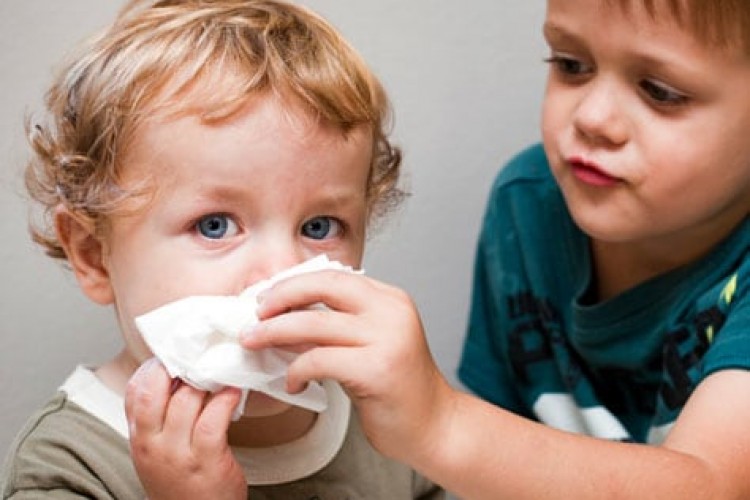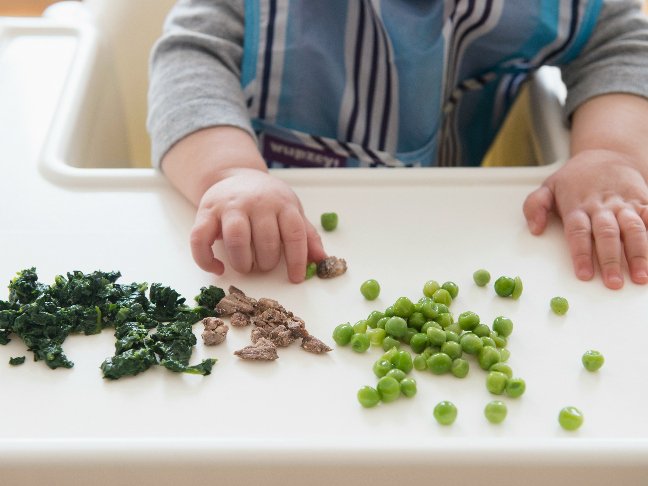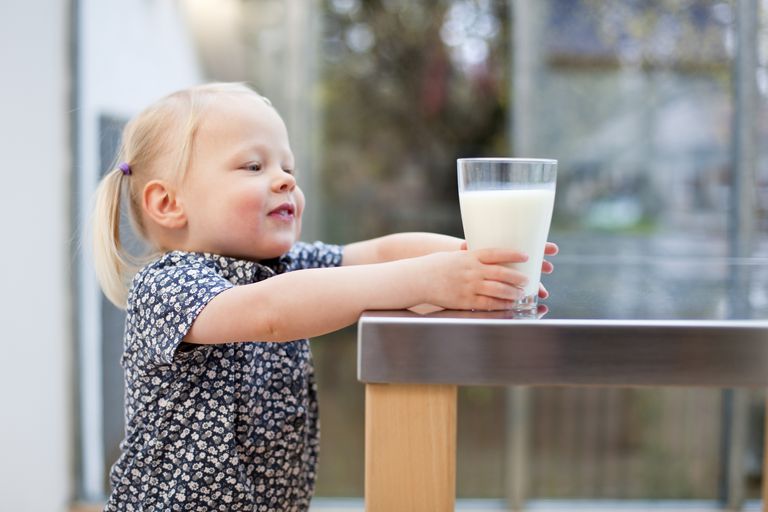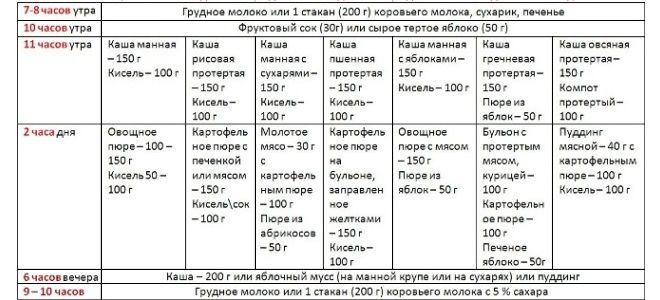In the article, we will consider how to create a menu for an allergic child.
Often in various sources, information appears that adhering to a strict diet for allergies can be not only useful, but also harmful. Therefore, the approach to building a diet for a child suffering from allergies should be comprehensive and deliberate.
Allergy is a disease that develops due to an inadequate response of the body to the ingestion of foreign proteins. Such substances can enter the body in various ways:
- Food.
- Parenteral. With such a hit, an allergy to insect poisons, drug allergy can develop.
- Contact. As a result, contact dermatitis develops.
- Aerogenic. This type of contact causes hay fever.
Prevention of food allergies involves the exclusion of certain foods from the diet. Menu for an allergic child can be quite difficult to compile.

Elimination diet
Such a diet is quite specific and involves the exclusion from the list of consumed foods only certain, specific, which cause hypersensitivity reactions. Specific diets are used if it is not possible to conduct an accurate diagnosis or in the case when the diagnosis is in the early stages.
To determine the allergen, one product is excluded from the diet and the patient's condition is monitored.
Nonspecific diet
Such a diet is basic. It is necessary to reduce the overall nutritional load on the body with the exception of allergens from the diet.
A similar diet is necessary for a person with an allergy of any kind and in the initial stages of allergy diagnosis.
Thus, the task of a hypoallergenic diet is as follows:
- Replenishment of the lack of excluded trace elements and nutrients by using other products.
- Decrease in the level of the general allergenic load.
- Exclusion of body contact with the allergen.
- Diagnosis of trigger allergen.
The first point is most important, since adherence to a strict hypoallergenic diet in children is necessary only during periods of severe exacerbations until therapy is prescribed. At other times, contact with food allergens should be avoided not so much as creating a balanced, nutritious diet that will account for such an exception.
Below we consider in more detail the diet menu for allergic children.
General principles for a hypoallergenic diet for children
When forming a diet, it is important to take into account the characteristics of the child's body.
In addition, it should be remembered that children have a higher (than in adults) need for fiber and protein. This is due to the high degree of activity of children (in particular, at the age of 3-7 years), as well as the need for proper nutrition of all organs and systems. However, practice shows that it is proteins of animal origin that are most often the cause of inadequate allergic responses of the body. This should be taken into account when drawing up the menu of an allergic child in 5 years.
Also important is the fact that an allergy to milk proteins has a high prevalence. There are some differences between adult and child allergies:
- In many children, the immune response is combined with an non-immune response. In such cases, the formation of a pseudo-allergy occurs.
- Often a place is polyallergenic sensitization.
- As a child grows up, the risk of cross-allergy increases.

The last difference is mainly due to the expansion of the children's diet.
If we take into account all the described features, then we can highlight the main principles of the formation of a diet for allergic children and a menu for the week:
- It is necessary to strictly control the balance, the fullness of the diet.
- It is important to exclude not only causative allergens, but also cross irritants.
- A prerequisite is the exclusion of products that are histaminolibrators.
- Sour milk products are allowed.
- It is important to exclude animal protein as much as possible, replacing it with vegetable.
- In the presence of food-type allergies, it is imperative that the trigger allergen be ascertained.
- It is necessary to follow a diet for any pathology of an allergic origin, whether it is contact dermatitis, hay fever, food hypersensitivity.
By a non-specific diet it is customary to understand the exclusion of all foods that are highly allergenic. Such a diet is prescribed at the first visit to an allergist with a complaint about a hypersensitivity reaction.
It is customary to use the most extended elimination diets. Specialists classify all products into three groups according to their allergenic activity:
- High activity products: any spices, celery, melon, all nuts, cocoa beans, chocolate products, baker's yeast, bananas, citrus fruits, tomatoes, chicken, fish, milk, chicken eggs.
- Medium activity foods: raspberries, pineapple, kiwi, grapes, apples, apricots, beans, peas, soybeans, beets, cucumbers, carrots, oat products, barley, rice, rye products, wheat, turkey, horse meat, pork, beef.
- Products of weak activity: lingonberries, cranberries, blueberries, lettuce, watermelon, pear, prunes, pumpkin, turnips, cabbage, zucchini, buckwheat, rabbit, lamb.
The pediatrician Komarovsky identifies among the products the six most active allergens: fish, wheat, milk protein, peanuts, soy, chicken.

Diet ado
The diet, developed by an allergist, immunologist, pathophysiologist A. D. Ado, involves the rejection of aggressive food and its replacement with a more sparing one.
The main advantages of this diet are:
- The possibility of introducing obligate allergens into the diet in turn, which allows you to determine the irritant that causes the reaction.
- The simultaneous elimination of all allergens, due to which the clinical manifestations of allergies are quickly eliminated.
- The presence of a specific list of products prohibited for use.
But this technique has certain disadvantages:
- There is no focus on the individual characteristics of the body of each child.
- Extreme nonspecificity.
Products prohibited for use by a child with an allergy
The Ado technique involves the use of the following products: apple compote, tea, sugar, baked apples, dill, parsley, fresh cucumbers, inedible white bread, rice, oatmeal, buckwheat, sunflower, butter, kefir products, yogurt, curd, vegetable, cereal soups, boiled beef.
From the menu for an allergic child should be excluded: alcohol, honey, muffin, pineapple, strawberries, strawberries, milk, quail, chicken eggs, mushrooms, eggplant. Tomatoes, spices, smoked meats, coffee, cocoa, chocolate, whole poultry, seafood, fish, nuts, citruses.
Ado Diet Example
The menu of an allergic child for a week according to the Ado technique can look like this.
Monday
- Breakfast: porridge made from oatmeal, cooked on the water, bread with butter, tea with sugar.
- Lunch: apple compote, coleslaw with vegetable oil, broccoli with boiled tongue, vegetable soup on the broth.
- Snack: peach juice, lingering cookies.
- Dinner: tea, beef meatballs, mashed potatoes.
- The second dinner: gingerbread, kefir.
The menu for a week of diet for children with allergies is made up of simple products.
Tuesday
- Breakfast: chicory, pancakes cooked on the water, apple jam.
- Lunch: tea, beef stroganoff, buckwheat on the water.
- Snack: inedible cookies, apple.
- Dinner: tea, cabbage rolls.
- The second dinner: inedible cookies, fermented baked milk.

Wednesday
- Breakfast: porridge on the water, tea, bread and butter.
- Lunch: tea, sausage, vegetable stew, vegetable soup.
- Snack: Viennese waffles, drinking yogurt.
- Dinner: sausage, stewed cabbage.
- The second dinner: gingerbread, kefir.
This menu is suitable for an allergic child 3 years old.
Thursday
- Breakfast: tea, bread, banana, yogurt.
- Lunch: dried fruit compote, minced meat cooked in a double boiler, noodles.
- Snack: prunes.
- Dinner: cranberry juice, sausage, vegetable stew.
- Second dinner: carrots with sugar and sour cream.
Friday
- Breakfast: cherry juice, raisins, baked apples.
- Lunch: tea, cabbage salad, stewed beef, mashed potatoes, pea soup cooked in vegetable broth.
- Snack: puff inedible, yogurt.
- Dinner: dogrose, tongue, green beans, cauliflower, boiled rice.
- The second dinner: gingerbread, kefir.
Saturday
- Breakfast: chicory, toast with cheese, rice porridge on the water.
- Lunch: tea, beef meatballs, buckwheat porridge.
- Snack: dried apricots.
- Dinner: vegetable soup, cucumber salad.
- The second dinner: cookies, fermented baked milk.
Sunday
- Breakfast: tea, cottage cheese casserole, jam.
- Lunch: chicory, coleslaw, boiled beef.
- Snack: banana, cottage cheese.
- Dinner: peach juice, sausage, noodles.
- Second dinner: dried fruits, yogurt.
We emphasize once again that such a diet menu for allergic children is suitable at any age, but older than 2 years.
Specific diet
A specific diet involves a diet based on the symptom complex of a certain disease and taking into account the presence of an allergy to certain irritants.
- Diet for respiratory allergies. If the child has hay fever, the elimination of cross allergens is important. This will prevent the development of oral allergies. The list of cross allergens depends on which pollen of the plant is the allergen. In the presence of bronchial asthma, it is important to exclude the use of honey.
- The diet for contact dermatitis, provoked by a non-food allergy, does not play a special role. If dermatitis is atopic and is due to the presence of food allergies, you should carefully form a diet.
- Food allergy. Such an allergy involves the exclusion of the trigger allergen and all cross-stimuli from the diet. There are several standard dietary tables: a dairy-free diet, a cereal-free diet, a diet with sensitivity to chicken egg protein, a diet for allergies to soy products, and a diet for allergies to mold and yeast.
Sometimes you need to create a menu without dairy products for allergic children.
Dairy-free diet
Dietary nutrition of this type is prescribed in the presence of sensitivity to proteins contained in cow's milk. If the child does not tolerate milk and products based on it, it should be excluded from the diet: condensed milk, cheese, ice cream, cottage cheese, yogurts, cream, fermented baked milk, kefir, whey, margarine, milk powder, cow milk.

Traces of milk are often found in sausages, sausages, biscuits, waffles, sauces, creams, sweets, and confectionery. Therefore, it is important to study the composition of a product before giving it to a child suffering from allergies. On the packaging, milk protein can be designated as lactoglobulin, lactalbumin, calcium caseinate, potassium caseinate, sodium caseinate, buttermilk, casein hydrolyzate, casein.
To compensate for the lack of dairy products in the diet can bean, soy, poultry, lean meat. In addition, people who are allergic to cow's milk often tolerate mare and goat milk, as well as many dairy products.
With a dairy-free diet, calcium and vitamin D are required.
Gluten free diet
If the child is allergic to cereals, it is necessary to exclude ice cream, soy sauce, chocolate, ketchup, mayonnaise, pasta, rolls, cookies, bran, breadcrumbs, bread, cereal side dishes, cereals, dishes based on wheat from the diet.
On the packaging, cereals can be designated as sodium glutamate, malt, vegetable starch, hydrolysates of vegetable protein.
Care should be taken to use products that contain flavors, thickeners, emulsifiers.
You can compensate for the lack of these products with corn flour, buckwheat, rice, rye, oats, and barley.
Diet for allergies to chicken eggs
In this case, sorbet, meringue, nougat, sausages, sausages, mayonnaise, some pastries, marshmallows, omelettes should be excluded from the child’s menu.
On the label, derivatives of chicken eggs can be indicated as vitellin, ovomukoid, ovomucin, livetin, lecithin, lysozyme, globulins, albumin.
Egg whites can be replaced with potato starch, gelatin, cottage cheese, soy flour, flaxseed.
Many parents are interested in how to create a menu for allergic children in 4 years?
Hypoallergenic nutrition for children of different ages
It is always important to consider that nutrition for children of different ages has certain features.
The main allergen for children under the age of one year is protein found in cow's milk. In this regard, products with its content are introduced into lure quite late, not earlier than the baby is 8 months old. As for the main nutrition, this issue is relevant for those children who are on mixed or artificial feeding. Mixtures in cow's milk are contraindicated in this case, it is necessary to use hypoallergenic products, for example: Frisopep AS, Pregestimil, Nutramigen, Tutteli Peptidi, Nutrilak Peptidi, Nutrilon Peptidi. If the child is also allergic to other products, it is necessary to use hypoallergenic mixtures, but it is allowed to use products that contain partially or moderately hydrolyzed casein: Theme GA, Humana GA, Nutrilon GA, Nutrilak GA.
If the baby is breast-fed, it is important to adjust the diet of the lactating woman - she should adhere to a gluten-free or dairy-free diet.
Such children should be given complementary foods later than in normal situations - not earlier than from 5.5 months.
And what is the menu of an allergic child per year? The most important diet therapy is between the ages of 1-3 years. Hypoallergenic nutrition for children per year:
- It involves the exclusion of highly allergenic foods from the child’s diet, the refusal to switch to a common table, and the reduction in the amount of salt, spices, and chemical additives. What else does the menu for a one-year-old baby allergy suggest?
- Sour-milk products can be consumed only in case of good tolerance. This must be taken into account when drawing up the menu of a one-year-old allergic child for a week.
- The use of milk is strictly prohibited.

Also, questions are raised by the menu of an allergic child in 2 years. At this age, a hypoallergenic diet allows the use of quail or chicken eggs (if the child tolerates them well), but does not allow meals on a common table.
Hypoallergenic diet in 3 years:
- It allows you to transfer the child to a common table, add fish and nuts to the diet.
- It is not recommended to feed the child with tomatoes, citrus fruits, mushrooms, strawberries, strawberries, tropical fruits, cocoa, chocolate, and also use spices.
The hypoallergenic menu for an allergic child of 3 years old differs, as a rule, only in the portion size, which is regulated by the age norms of feeding. That is, the set of products that can be used to feed a child 4, 5 years old and older is not different.
It should be noted that it is much easier to control the menu for allergic children at 4 years old than teenagers. Therefore, it is important to explain to the child why he should not eat certain foods.
In adolescence, foods with flavoring, flavoring, coloring, fast food, alcohol are prohibited.
You should always remember that the formation of a sample allergy-sensitive menu is a responsible process, during which it is important to consider many factors, including the type of allergy, trigger factor, and the age of the child. That is why the preparation of the diet is best trusted by a specialist.
It must also be remembered that adherence to a hypoallergenic diet by a child is the main and most important element in the treatment of allergic disease.
Menu recipes for allergy sufferers
Millet porridge with pumpkin:
- It is necessary to peel and cut into cubes 200 grams of pumpkin, pour it with a glass of water, send it to stew for half an hour.
- Rinse and add 0.5 cups of millet to the pumpkin.
- Add 1.5 cups of water to the pan.
- Add salt and sugar to taste, cook for 20 minutes.
Broccoli vegetable stew:
- Peel, chop, put onions, carrots, potatoes in a stewpan.
- Pour with water, salt, simmer for 20 minutes.
- Add frozen broccoli and peas to the vegetables, mix, cook for 20 minutes.
- Garnish with parsley and herbs.
Gluten-free, dairy-free and eggless muffins:
- Peel and cut 100 g of apple (zucchini, bananas, pears are allowed), pour a glass of water, grind with a blender.
- Add 5 grams of pre-slaked vinegar.
- Sift 180 g of rice flour (you can use corn) into a separate bowl, add salt, 120 g of sugar. Pour the resulting mixture to the fruit, mix.
- Pour 180 ml of vegetable oil, mix.
- , 180 .
:
- .
- , .
- , , , 4 , .
- , .
- , .
:
- , .
- , , , , .
- , .
- , , , , , .
- 15 .
- , 5 .
- .
:
- Bring a liter of water to a boil, pour vanilla, half a glass of sugar into it.
- Add cherries, boil for 2 minutes.
- Add 2 tablespoons of starch to a glass of cold water.
- Pour the resulting solution into a pan with cherries, cook for 5 minutes, stirring continuously.
- It is recommended to cool before use.
Compliance with a special diet in case of allergies in a child, careful monitoring of his condition often allows you to completely get rid of allergic manifestations. As the baby grows, his digestive system grows stronger, susceptibility to allergens decreases and can completely disappear by 7 years.

Menu in the garden for children with allergies
There are currently no clear rules for the organization of nutrition for an allergic child in a preschool educational institution, which are prescribed in any regulatory act. Thus, in each kindergarten this issue is resolved separately. But in any case, the leadership is obliged (preferably together with parents) to think about how to help the child.
There may be various options for arrangements for organizing meals for an allergic child between parents and the DOU management: a separate diet table, only lunch in the garden, your own food (an unlikely event, as this will result in a violation of existing rules for providing food).
This is what an ideal development scenario looks like if the management conscientiously treats its work and fulfills all the obligations imposed by law. In practice, the situation is completely different. Often, parents of allergic children are denied the provision of such conditions, based on the fact that the usual DOW does not have the ability and / or is not required to cook separately.
We examined how to create a menu for an allergic child.